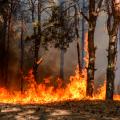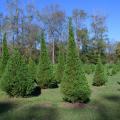Best Management Practices
Best Management Practices (BMPs) are guidelines for controlling non-point source pollution and maintaining forest productivity. They are flexible, workable guidelines which are adaptable to a very wide range of silviculture practices and site conditions. By adhering to the BMP guidelines, water pollution should be significantly reduced from forest management activities, and site productivity should be enhanced.BMPs address five major areas of forest management activities: roads, harvesting activities, site preparation work, revegetation efforts and streamside management zones or filter strips.
Access Roads
The guidelines for installation and maintenance of roads address both temporary and permanent roads. Road construction and/or lack of proper maintenance is the major cause of soil erosion from forested areas. Prior to any road construction, aerial photographs, topographic maps, property maps and soil maps should be utilized to plan out the road prior to any clearing.
The planning should minimize the number of stream crossings necessary. When it is absolutely essential to cross a stream, the road must cross the stream at a right angle, perpendicular to the stream flow at the point of crossing.
When possible, a major road should be built on a ridge to reduce problems of erosion which might arise with roads on slopes.
Culverts and bridges should be used under certain conditions. Cutting undesirable trees and shoving them into the stream with soil pushed over them for covering to be used as a bridge is a temporary measure only and the material must be removed after harvest activities are completed.
Roads should not be laid out up and down a slope greater than 10 percent. When roads are installed down the slope, water bars should be used according to the guidelines provided in the BMP handbook*.
Harvesting Activities
From a BMP perspective, building and maintaining proper roads and drainage systems are of greatest importance in harvesting activities. Skid trails, too, should be planned on areas before harvesting begins. Preferable, skid trails should be kept on grades below 15 percent, and turnouts should be used to divert the water.
Heavy equipment should be dept off rocky slopes when possible. Harvest crews should always leave filter strips along streams, and all logging debris should be kept out of streams. Even if a tree is felled and goes into a stream, it should be removed. The crown of the tree should always be removed from the stream prior to bucking the stem into logs.An area off-site should be designated for the service of machinery. Grease tubes, oil cans, and hydraulic fluid containers are a serious form of litter, and can cause water pollution if the contents of the containers get into the surface flow of the water and subsequently into streams.
Site Preparation Activities
BMP guidelines for site preparation include mechanical work, chemical word and burning. Mechanical site preparation includes shearing, chopping, windrowing, disking and bedding. Mechanical or chemical site preparation may be good or bad on a given site. The choice of operation depends more on the situation.In general, keep any and all blade attachments out of the soil: V-blades or KG blades, should never be put into the soil.
Heavy equipment should be kept off steep terrain during site preparation work. Heavy equipment should be kept off saturated soils.
Windrowing should not be used unless absolutely essential as it is the most disruptive activity for the mineral soil on any given forest site. It has the potential for producing a great deal of erosion and surface runoff into streams and other bodies of water. If windrowing must be used, install windrows in short blocks along the contours and not up and down a slope.Some mechanical site preparation, such as disking and bedding, is necessary to amend soil problems. Disking should be restricted to level areas. In many cases, subsoiling would be a better idea.
Chemical site preparation work includes preplanting and/or release type operations. BMP's include soil applied, basal bark, injection, ground machinery application and aerial work. The use of herbicides can be an excellent alternative, especially on sites which have highly erosive soils and/or slopes that are too steep for the use of heavy equipment.
Overall, anyone using chemicals should be extremely careful in storage, transport, mixing and application procedures. It can be tempting to mix the chemicals near a water source, but such practices are not allowed. Chemicals must stay out of the water. A USDA Forest Service researcher put is succinctly: "If you don't want chemicals in the water, don't put chemicals in the water." Forest chemicals should be applied only in accordance with the label and only by certified personnel. The BMP handbook provides guidelines for buffer strips to be used in chemical application areas, to lessen any potential problems.
Burning
The problems with burning if forest management activities are primarily from two sources: installation of fire lines and excessive heat.
Historically, streams or other bodies of water have been used as natural fire breaks. Under the BMP guidelines, natural bodies of water still can be used as fire breaks. Fire control lines should not be run into streams and swamps, because that promotes direct surface flow into the bodies of water. Fire lines should not be run directly across contours. With a little preinstallation planning potential problems can be avoided.
Excessively hot burns should be avoided. When the temperature of the fire passes certain points, soil structure can actually be damaged, thus reducing infiltration and percolation rates. This promotes more surface runoff and subsequent erosion, with a resulting reduction of water quality.
Revegetation Work
Revegetation activities, as they apply to forest management, include the establishment of temporary or permanent vegetative cover in order to reduce soil erosion. The BMP guidelines, in general, are directed toward roads and/or log landing areas. The seeding rates and fertilizer requirements for such work are available from the USDA Natural Resources Conservation Service and the BMP handbook provides guidance.
Streamside Management Zones (SMZs)
Streamside management zones (SMZs), will become permanent fixtures on the land. SMZs are the greatest protection against siltation of a stream. Even if some soil movement occurs across the harvested or site prepared area, SMZs can do a great deal to reduce the amount of sediment which actually enters the stream.
The width of the SMZ depends on the slope and the erosive nature of the soil involved. The width could vary from a minimum of a few feet up to hundreds of feet. The actual determination must be made on a site-by-site basis.SMZs are not removed from production. They merely represent areas in which activities must be restricted to minimize disturbance. For example, trees may still be harvested in such areas. All heavy equipment should be kept out of the area unless absolutely essential. Burning should not be allowed in SMZ's, and chemicals should be kept out. However, the area is not totally lost to timber production and it does provide a valuable service in reducing potential non-point source pollution.
Who Is Responsible?
Ultimately, the timber owner is responsible for adherence to BMP guidelines. However, it will take a concerted effort by the landowner, foresters involved in management activities, and harvesting crews to ensure a full understanding of the guidelines and assurance of compliance with them. The more formal the agreement among the involved parties, the more likely the assurance of compliance.
Mississippi's silvicultural BMPs are currently listed as in the voluntary compliance phase. They have been developed and submitted to the U.S. Environmental Protection Agency (EPA) in Washington, D.C., and the EPA has gives approval for the guidelines as presented. That means that they are guidelines, and not laws yet. The Mississippi Forestry Commission is requiring compliance with BMPs from landowners who are using cost-share programs.
Publications
News
Did you know that wildfire is a common occurrence in Mississippi? If you live in the rural-urban interface – areas where human development moves into rural areas – your risk of being affected by wildfire increases.
Landowners working to improve game bird habitat can sign up for Feb. 28 and March 1 weekend events that provide practical information for property management.
The Mississippi State University Extension Service is hosting the turkey and quail management social and workshop in Shannon, Mississippi.
RAYMOND, Miss. -- Mississippians who want to deck their holiday halls with a locally grown Christmas tree will have no problem finding one. Although weather conditions have tested the state’s growers over the last two years, tree inventory is strong.
Success Stories
Fenton Pope looked around his native Covington County a quarter-century ago and saw what he believed was an alarming amount of farmland out of production.
Gaddis & McLaurin might sound more like the name of a law firm than a general store, but the name is synonymous with all manner of dry goods in the Hinds County community of Bolton and has been since the 1870s.
In an industry where every piece of equipment can seriously hurt the operators and crew, one Mississippi logging company has not recorded an accident during more than 40 years of operation, from Brandon to Gulfport.






